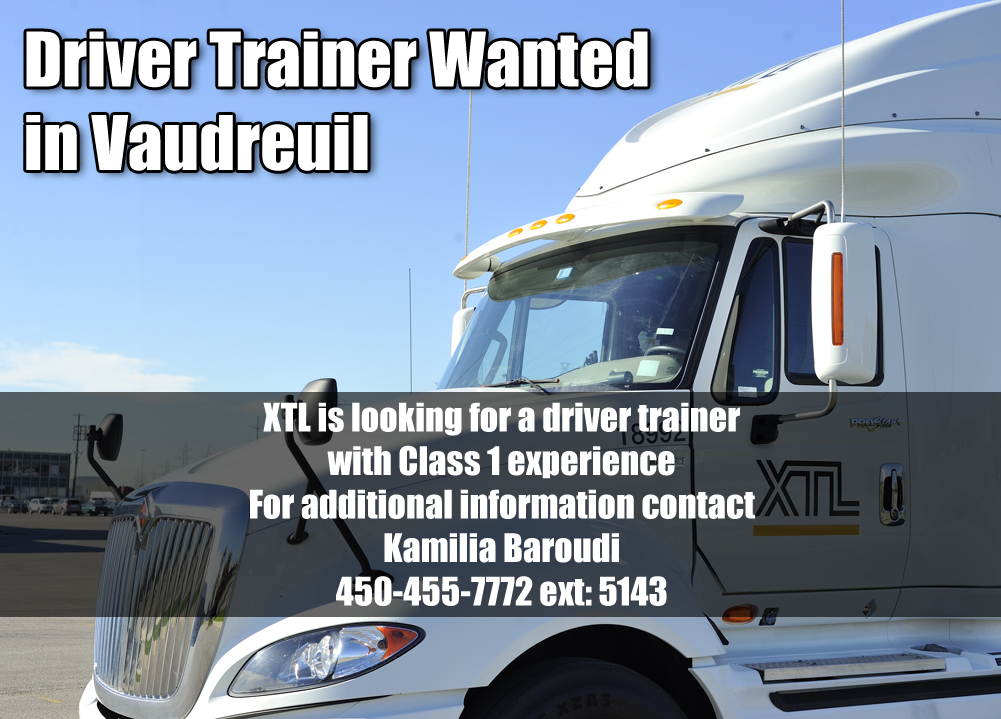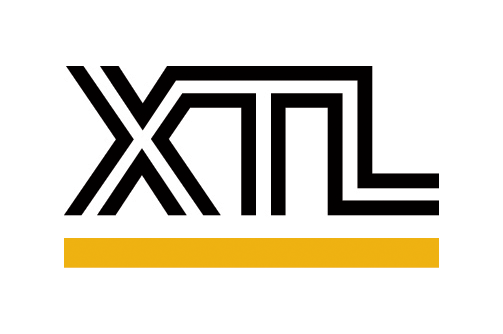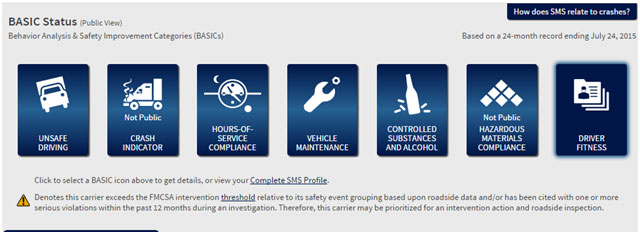
Category: English Versions


The Ontario government just set mandatory training course guidelines and hours of training for new and prospective truck drivers. The new training and minimum hours regulation will come into effect July 1, 2017. This is generally supported positively by the trucking industry.
The trucking industry needs a well trained stream of drivers coming into the system on a regular basis to keep up with growing demand and retiring drivers. In the past, the exact training new drivers had was difficult to determine due to varying standards and forced many trucking carriers to provide additional in depth training of their own. This is a costly proposition.
The trucking industry has always focused on fairness and level playing fields. This new regulation ensures all new drivers come out of the system with a similar level of training. While the response to these new regulations is mostly positive, there are those who don’t think it goes far enough. The regulation calls for 103.5 hours of training on various topics in the classroom, in the yard and on the road. There are some of better training schools that currently offer a minimum of 200 hours of training and see 103.5 hours as a downgrade to current practices.
Here at XTL we differentiate ourselves from others in the Industry by our robust training.
- Driver training is geared to their personal record. (Driver CVOR is reviewed, tailor made to the drivers experience and violation history).
- Driving skills training is included.
- Fuel efficiency training is included.
- Operations/Maintenance tasks are involved in Driver training.
- Driver engagement – Leaving the Driver alone after training is not beneficial. So, here at XTL we train, coach and mentor our drivers on the road as an extension to our in class training.
- Drivers are trained on the pressures of their Job. Drivers have one of the hardest jobs to do and we recognize that by how we treat them.
- We develop a Driver Manager/Driver Engagement code that covers working conditions for DM’s and drivers on how they engage with each other. This manages DM’s and Driver Expectations.
- We make the training more Relationship-oriented vs. process-oriented.
- In training we make them understand that they are a true Asset to the company. Drivers are respected. “Happy Drivers are Productive Drivers”.
XTL takes safety seriously and supports new and novel practices that increase the safety of our drivers and the general public.

We need your vote! We excel in transportation services and are nominated for the 15th Annual Shipper’s Choice Awards. Please help us by nominating us.
The Canadian Shipper magazine is benchmarking the performance of transportation suppliers in all modes and we need you and your vote.
For over a quarter of a century, XTL has consistently met the increasing logistics demands of its customers all across North America. We strive to always put the customers’ priorities at the centre of the equation and design a value network to meet our customers’ needs. We believe in improvement and are continually building and managing strategic alliances to deliver seamless logistics plans to our customers.
At XTL, we understand that every shipment you make is vital to the success of your business and that your corporate reputation is always “on-the-line” so there’s zero room for error that will cause costly mistakes.
Our reputation, philosophy, and proven track record has been paramount in us establishing many long term working relationships with multiple partners, and has allowed us to become one of North America’s largest transportation companies.
We rely on and value your input as a buyer and/or influencer of transportation services to vote for us as an outstanding supplier in the truckload category.
We work very hard to provide the very best service in truckload and logistics services to ensure that our customers are 100% satisfied. We hope to be voted as one of the nation’s best carriers. This vote is very important to us because our goal every day is to have the right people on staff and provide the best services for your logistics operations. We are always committed to our valuable customers.
You know that you can count on XTL for all your truckload needs and now we trust we can count on you! Please vote XTL as your Top 3PL and thank you for your continued support.

If you haven’t heard, the FMCSA just published their final rule in regard to ELDs (sometimes called EOBRs or AOBRD) and compliance for the hours of service regulations.
Carriers and drivers who are subject to the rule must install and use ELDs by the appropriate deadline:
- Carriers and drivers who are using paper logs or logging software must transition to ELDs no later than December 18, 2017.
- Carriers and drivers who use AOBRDS prior to the compliance date must transition to ELDs no later than December 16, 2019.
Industry-wide ELDs are one of the safest things that could happen to protect drivers in the industry. ELDs provide critical driver information about how many hours they’ve worked and how many hours they have left to do the work. A carrier’s operations department also has access to all the information they need to dispatch the right driver at the right time. In a matter of seconds a carrier’s operations department has information on the location of the drivers and also how many hours are available for the driver to give the best service. The driver has no pressure from operations and as a result is under less stress which equals a better quality life. The trucking company can also use this data to perform delivery and reaction time analysis. It is much easier for everyone and helps planners be more accurate.
What is an ELD?
It is defined as an electronic logging device an ELD synchronizes with a vehicle engine to automatically record driving time, for easier, more accurate hours of service (HOS) recording.
The new rule:
- Specifies who is covered by the rule and exceptions to it.
- Provides for ELDs to be certified, registered, and listed on a FMCSA website.
- Includes technical specifications to ensure ELDs are standardized and compliant.
- Includes a phased implementation timeline to give drivers and carriers time to comply.
- Includes provisions to help prevent data tampering and harassment of drivers.
- Creates standard data displays and data transfer processes, making it easier to demonstrate compliance and faster to share RODS (Record of Duty Status) with safety officials.
What is an AOBRD or EOBR?
AOBRD = Automatic On-Board Recording Device has been defined since the 1980’s as: “an electric, electronic, electromechanical, or mechanical device capable of recording driver’s duty status information accurately and automatically as required by §395.15.
EOBR = Electronic on-board Recorder
Both terms are used essentially to describe an ELD. However, they are older terms used in previous legislation. The most current term is “ELD”. Any references to “E-logs” or “ELogs” are generic references to AOBRDs and ELDs.
What are some of the benefits of an ELD?
- An ELD will decrease paper work load for the driver. Hopefully, saving some duty time.
- Save planning time- For carries it should allow them to have real time visibility into a drivers HOS status.
- Precise information- For carriers it should simplify, if not eliminate auditing of paper records.
- Accuracy- It should increase compliance and reduce citations for violations as paperwork errors will be dramatically reduced.
- Load distribution very accurate.
- System is very easy to implement.
What are some of the larger impacts to the industry?
Inherent in any paper tracking system is the ability to game the system. Not all drivers in the industry are 100% compliant with their log books, as evidenced by the many citations issued for HOS non-compliance. Some can be chalked up to driver error, but many can also be attributed to drivers pushing the envelope on how they record their time in order to drive more hours. This creates an un-level playing field for companies and drivers that are compliant within the HOS regulations. ELDs should make it more difficult, if not impossible for drivers to game the system. As an industry, we should see greater compliance and hopefully a reduction in crashes due to the greater compliance.
Another impact could be a greater tightening of capacity. If the industry, presumably, is now removing a whole bunch of illegal non-compliant driving hours from the system; which is a good thing! However, it’s going to exacerbate an already existing driver shortage issue because now those illegal driving hours have to be replaced with legal ones. It could drive up driver pay and transportation rates.
On a more positive note, the mandate is estimated to prevent more than 500 injuries per year, save approximately 26 lives annually and reduce administrative expenses. The net regulatory financial savings of ELD implementation is estimated at more than $1 billion industry wide.
What we’re doing at XTL
At XTL, all our trucks are equipped with the system already. We have 400 trucks across Canada.
Our owner operator drivers are not on ELDs yet. They already have the system in the truck; however, it is not active yet. It’s just a matter of time before ALL our fleet is on an ELD.
ELDs are mandatory for all the drivers that join our team under XTL’s new policy with the exception of owner operators, who have until December 2017 when it will be mandatory. At XTL, we have 72 owner operators. Safety and great service are always our priority. We are here to help with all your transportation needs.
Dear clients
The Ministry reminds users of heavy vehicles and shippers that the local limits permitted are reduced during the thaw period.
During the 2016 that period, the beginning and end dates of load restrictions for each zone are as follows:
Zone 1: From Monday, March 14th (12:01am) to Friday, May 13th (11:59pm)
Zone 2: From Monday, March 21 (12:01am) to Friday 20 May (11:59pm)
Zone 3: From Monday, March 28th (12:01am) to Friday, May 27th (11:59pm)
*The beginning and end dates of load weight restrictions may vary depending on weather conditions.
If shipping goods in other Canadian provinces, please consult the websites of the respective Ministries of Transport www.mto.gov.on.ca, www2.gnb.ca to get information updates.
In addition, we would like to remind you that we offer different transportation options during the reduced weight period for various axle configurations. Thus, through our diverse fleet of trailers and flexibility of our services, we can easily adapt to your needs.
Do not hesitate to contact our customer service agents, they will be pleased to find effective and efficient solutions for the transportation of your goods during this critical period.
Thanks for your help,
Customer Service Team
XTL Transport Logistics Distribution

Uber has certainly disrupted the taxi industry. eBay and Alibaba, and Amzon have certainly disrupted the on line retail business and sites like Airbnb have certainly disrupted the room for rent industries. The question I often hear is that will an industry “disruptor” emerge offering some sort of online shipper-driver matching service that completely changes the whole industry? I think not!
Here are many reasons why I think it will be unlikely that an “Uber-Like” web application will change the trucking industry:
They already exist!
There are a lot of load matching services out there. Many are free, some are pay for service and if anybody has watched “Shipping Wars” on TV it’s pretty obvious that the technology already exists to get truck drivers bidding against each other for freight. While there is a market for this type of shipment, it’s not really changing the whole industry. It’s mainly small or one time shippers getting bids from freelance truckers. It’s too much hassle for a regular shipper to bid out each and every shipment and qualify each and every freelance trucker. It’s just not going to happen. Plus, regular shippers are generally looking for a trucking or logistics “service” as opposed to just a single shipment.
A Driver is Not Alone
Unlike the comparison to a taxi driver at Uber, a truck driver is rarely a lone wolf. He’s supported by a dispatch department that helps him coordinate pick-ups and deliveries so that he can do what he’s paid for….to drive. A driver is also supported by a maintenance department, a safety and training department, not to mention the financial strength of an entire company to fund his endeavors. Plus, there are customs experts to help him get his paperwork right and off to the border.
Safety is a Huge Issue
While a fender bender in an automobile is still a terrible thing, any minor accident by a truck can result in serious consequences. Not only does the size and speed of a truck come into play, but the cargo it’s carrying could be dangerous or environmentally hazardous if spilled. The risk is just too great for any responsible company to bid out shipment by shipment to anyone who will take it for the lowest price. There is huge corporate liability here. Any company serious about doing their due diligence in carrier selection will want to do business with a carrier who is providing a transportation service rather than an individual driver.
Supply and Demand
Anyone who’s ever tried to get a shipment on a truck knows that sometimes it’s easy and other times, it’s near impossible! Different areas of the country and different laneways experience different levels of supply and demand all year long. The only leverage you have during peak seasons is the regular freight and business relationship that you have with trucking companies to find a way to get a truck to your pick up with capacity to move it. If you were to rely solely on the open market and a bidding system, with one off loads, your costs and service would go haywire with the ups and downs of the seasonal markets. It just wouldn’t be a viable year round transportation plan that would work.
Capital Investment
Unlike Uber where pretty much anyone has a car and a driver’s license, tucking is a very capital intensive industry. A single truck and trailer could cost hundreds of thousands of dollars, not to mention the required training and investment in driver training that is required. An Uber-like trucking service is going to have difficulty attracting drivers willing to invest in their own equipment in an industry that’s already short on drivers. Plus, where the goal is to get drivers to bid against each other to lower the cost, it’s unlikely that the industry would attract new drivers to meet the demand of the industry.
About XTL Transport
XTL with their strong team of experience drivers, logistics personnel and first class, fleet have been providing a remarkable transportation service for over 30 years, and we will continue to do so! If you would like a free transportation review of your current transportation plan; contact XTL today for a free consultation and transportation review.

If you’re a shipper or transportation company, this time of year, in the final months leading up to the new year you have to ask yourself, “what’s the outlook for next year?” We don’t have a crystal ball, but here’s how we see it.
Fuel Prices
Prediction: Most predictions are for fuel prices to remain relatively low next year.
• Most economies are slow or slowing.
• There is a glut of supply and the Middle East doesn’t seem to be slowing production.
• More fuel efficient vehicles are actually starting to effect demand for gasoline.
• Natural Gas is a very economical alternative right now due to the new fracking technologies recovering previously unrecoverable resource.
What could affect this prediction?
• A major conflict in the Middle East.
• OPEC deciding to cut production.
Labour Shortage
Prediction: Continued driver shortage
This seems like old news, but every year the shortage of truck drivers seems to increase. We can expect more of this next year.
• Existing truck drivers are retiring at a faster rate than new entrants.
• The market for freight is growing and the demand for drivers is growing.
What could effect this prediction?
• A major recession.
• With the oil boom slowdown, trucking companies may be successful at attracting new drivers from the oil patch labour pool.
• Trucking companies are heavily marketing jobs to women. Women currently make up only a small fraction of truck drivers. Should female truck drivers become a trend, it could really help out the driver shortage problem.
Capacity
Prediction: More available capacity in 2016
Coming into the end of the year spot market capacity is up (according to DAT Trendlines) and spot market loads are down. This is a key indicator that freight volume is soft right now. From a capacity perspective we should see much more available capacity in 2016.
• Q3 2015 freight volumes are soft.
• Trucking companies being proactive about hiring and recruiting.
• Outlook for economy is soft.
What could effect this prediction?
• New rules or regulations that could tighten capacity.
• An economic boom.
Traffic Flow
Prediction: Increased southbound traffic to the US, softer northbound traffic to Canada, less East-West traffic in Canada.
• With the low Canadian Dollar, imports are considerably more expensive. This will drive less import from China and the US.
• With the low Canadian Dollar, Canadian Exports will be more attractive, particularly in the United States. More exports should shift to the US.
What could effect this prediction?
• A World Wide economic boom, or oil price shock, could appreciate the Canadian Dollar and reverse this trend.
What Do You Think?
XTL wants to know what your predictions are for 2016. Drop us a line, or comment on our post and keep the discussion alive.

 Over the last few winters, Mother Nature has not been particularly kind. Frigid temperatures and huge snow storms caused havoc for many shipper’s and carriers alike. XTL has published some great articles over the last few years about temperature controlled transport and best practices during heat season. Here’s a list of the content we have on our blog as a resource.
Over the last few winters, Mother Nature has not been particularly kind. Frigid temperatures and huge snow storms caused havoc for many shipper’s and carriers alike. XTL has published some great articles over the last few years about temperature controlled transport and best practices during heat season. Here’s a list of the content we have on our blog as a resource.
Extreme Weather Events Impact Logistcs
How to Increase Heated Freight Capacity During Winter
Heated Service vs. Protect From Freeze
Best Practices in Temperature Controlled Transport
“Hot” Tips from our past articles:
- Keep an eye on the weather forecast. Get critical orders or supplies moving before the storm hits.
- Work with your carriers. There are often huge costs incurred when a shipment gets stuck in a storm. Be prepared to share the costs within an ongoing relationship.
- Increase your inventory levels of critical items to ensure you’re not caught short by a big winter storm.
- Ship heated freight and non-heated freight separately. You may be able to get two smaller shipments moving rather than one large one when capacity is tight.
- Consider “no heat” on short runs where your product is unlikely to freeze.
- Consider blanket wraps to get a shipment moving when capacity is tight.
- Understand the difference between “heated” and “protect from freeze” service and how this impacts your shipments.
- Book early during inclement weather. Don’t wait till the last minute.
- Be aware of the risk of freeze in all steps in your supply chain; from loading, during transit and during unloading.
- Get your product off the floor! Make sure liquids are on pallets if possible. Separating contact with the floor will prevent heat transfer.
- Keep product away from the walls. The closer the product is to the walls of the trailer the more likely for heat transfer to occur.
- Put the most freeze sensitive product at the front of the trailer. Especially if it’s an LTL shipment, near the doors gets exposed more to outside temperature.
Other “Hot” Tips for Temperature Controlled Freight
XTL’s TEMPSOLUTION
Just a reminder that XTL specializes in temperature controlled transport. Plus, we’ve got a specially designed TEMPSOLUTION trailers that are specially insulated and have state of the art temperature control units. We saw the need clients have for shipping extremely temperature sensitive products in a safe and controlled manner and responded with our TEMPSOLUTION trailers. Check out our TEMPSOLUTION page for more information, or contact us. We’re here to help.

The demand for truck drivers has never been higher; the industry is growing, adopting new technology and is a key driver of our economy. Ever considered a career in trucking? Maybe you should!
A rewarding career
Almost every consumer product and foodstuff arrives by truck to the end consumer. Without truck drivers, our economy wouldn’t be able to function, let alone feed, cloth, and house a nation. The trucking industry is an important part of the Canadian Economy.
You’ll be in high demand
According to a recent Conference Board of Canada study (2013), it’s predicted that across Canada there will be a shortage of between 16,600 and 33,000 drivers by 2020. This is largely based on industry growth and a high number of retirees in the years to come.
Recession Proof
Because of the general lack of truck drivers, during the last recession, trucking companies were still hiring. This trend is expected to continue as the demand for drivers grows.
Choice and Freedom
Due to the high demand for truck drivers currently and for the foreseeable future, you’ll be able to pick your employer. If one is not a good fit, you’ll be in such high demand that you’ll be able to choose a trucking company that is a better fit for you.
Cutting Edge Technology
The trucking industry is becoming more technologically advanced every year. From onboard GPS vehicle tracking to satellite computer systems and communications technologies, the truck driver of the future will be more ‘wired’ than ever before.
Lots of Training Resources
There are a lot of training resources for truck drivers such as: the Professional Truck Driver Institute, Trucking HR Canada or a provincial authority, such as the Atlantic Provinces Trucking Association.
Opportunities for Advancement
There are career paths beyond truck driver that can lead to Driver Trainers, Driver Supervisors as well as Fleet Management and Operations Management careers.
Choice of Work
Not all truck drivers are on the road for extended periods of time. Of course, many people choose long haul positions because of the freedom and the ability to travel they offer, but there are also many local and short haul positions available in the industry.
An Industry That’s Actively Seeking Women
According to statistics, 97% of drivers are men. This is something the industry wants to change. If you’re a female looking for a challenging and rewarding career, trucking may be for you.
XTL Transport is Hiring
If you’re considering a career in trucking, please contact us, we’d love to talk to you. XTL offers many benefits to new drivers, including training and mentoring programs. You can find more information and contact us on our website here.

The FMCSA (June 29,2015) has just released proposed changes to the Compliance, Safety, Accountability (CSA) program. The changes are reflected primarily in changing intervention thresholds for BASIC measurement categories in their Safety Measurement System (SMS).
A note about how the system works:
Keep in mind while reading this article that the SMS is a ranking system not a rating system. So if a threshold is set at 80%, say. It means that to “pass” you have to be ranked in the top 80% of all carriers for this BASIC.
Why the Changes?
The main changes fall on changing compliance thresholds. The FMCSA has taken a look at each of the BASICs in their Safety Management System (SMS) and correlated them to crash risk. If follows that higher crash risk BASICs should have a tighter compliance threshold while BASICs that have very low correlation to crash risk should have lower compliance thresholds.
HIGH CRASH RISK BASICs: Unsafe Driving, Crash Indicator, Hours of Service (HOS) Compliance
MEDIUM CRASH RISK BASICs: Vehicle Maintenance
LOW CRASH RISK BASICs: Controlled Substances, Hazmat Compliance and Driver Fitness
What are the Changes?
Intervention Thresholds at 65%: Unsafe Driving, Crash Indicator and HOS Compliance will all remain at 65%. That means if you are in the bottom 35% of all carriers you should continue to expect intervention activities.
Intervention Thresholds at 75%: Vehicle maintenance was previously 80%, meaning the bottom 20% of carriers would receive intervention. This is now changed to 75% meaning the bottom 25% of all carries will receive intervention. So, more carriers are likely to fall in the intervention category for this BASIC.
Intervention Thresholds at 90%: To reflect the lower crash risk, Controlled Substances, Hazmat Compliance and Driver Fitness will be lowered to 90% from 80% (I know that seems backwards!). This means that instead of the bottom 20% of carriers requiring intervention, only the bottom 10% will require intervention. So, less carriers are likely to warrant compliance interventions for these BASICs
Other Major Changes
The FMCSA is also proposing to segment Hazmat Compliance by vehicle type. Bulk Tank Carriers usually have very high compliance in this area, while packaged goods carriers often have trouble. This is because of the wide range of clients a packages goods carrier may have on a single vehicle as well as, being susceptible to many more opportunities for violations vs. a tank truck carrier. Since this is a ranking system, it’s unfair to compare bulk tank carries with packaged good carriers in the same ranking system.
Here at STL safety is always top concern.
XTL Transport Inc maintains a safety record below the intervention threshold in all categories. You can check out our profile at:
https://ai.fmcsa.dot.gov/SMS/Carrier/272768/Overview.aspx

